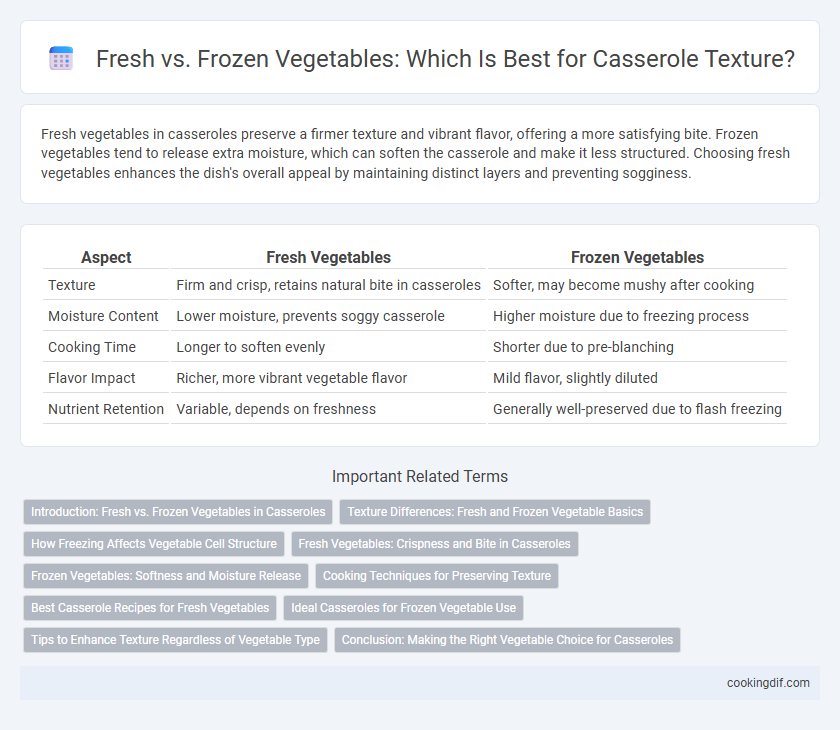Fresh vegetables in casseroles preserve a firmer texture and vibrant flavor, offering a more satisfying bite. Frozen vegetables tend to release extra moisture, which can soften the casserole and make it less structured. Choosing fresh vegetables enhances the dish's overall appeal by maintaining distinct layers and preventing sogginess.
Table of Comparison
| Aspect | Fresh Vegetables | Frozen Vegetables |
|---|---|---|
| Texture | Firm and crisp, retains natural bite in casseroles | Softer, may become mushy after cooking |
| Moisture Content | Lower moisture, prevents soggy casserole | Higher moisture due to freezing process |
| Cooking Time | Longer to soften evenly | Shorter due to pre-blanching |
| Flavor Impact | Richer, more vibrant vegetable flavor | Mild flavor, slightly diluted |
| Nutrient Retention | Variable, depends on freshness | Generally well-preserved due to flash freezing |
Introduction: Fresh vs. Frozen Vegetables in Casseroles
Fresh vegetables in casseroles provide a vibrant texture and crispness that enhances the dish's overall mouthfeel, retaining more natural firmness when cooked properly. Frozen vegetables offer convenience and consistent quality while maintaining a slightly softer texture due to the freezing process breaking down cell walls. Choosing between fresh and frozen depends on desired texture, cooking time, and seasonal availability, with fresh often preferred for a firmer bite and frozen for ease and cost-effectiveness.
Texture Differences: Fresh and Frozen Vegetable Basics
Fresh vegetables provide a crisp and firm texture in casseroles, maintaining their natural bite and preventing sogginess during baking. Frozen vegetables often release more water, which can lead to a softer, sometimes mushy texture if not properly drained or pre-cooked before adding to the casserole. Understanding these texture differences helps achieve the desired consistency and overall mouthfeel in vegetable-based casseroles.
How Freezing Affects Vegetable Cell Structure
Freezing vegetables causes ice crystals to form within the cell walls, rupturing cell membranes and leading to a softer texture once cooked in casseroles. Fresh vegetables maintain firmer cell structure, providing a more distinct bite and preventing excessive moisture release during baking. The compromised cell integrity in frozen vegetables can result in a mushier casserole texture and altered water content.
Fresh Vegetables: Crispness and Bite in Casseroles
Fresh vegetables provide a superior crispness and bite in casseroles, enhancing the overall texture and flavor complexity. Their higher moisture content and natural firmness help maintain structural integrity during baking, preventing a soggy or mushy dish. Using fresh ingredients elevates the sensory experience, delivering a vibrant and satisfying casserole texture.
Frozen Vegetables: Softness and Moisture Release
Frozen vegetables in casseroles tend to release more moisture during cooking, which can result in a softer texture compared to fresh vegetables. The freezing process breaks down cell walls, causing frozen vegetables to become less firm and more prone to becoming tender or even mushy when baked. This moisture release can affect the casserole's overall consistency, making it important to adjust cooking times or liquid quantities for optimal texture.
Cooking Techniques for Preserving Texture
Using fresh vegetables in casseroles typically results in a firmer texture due to their naturally higher water content and crispness. Frozen vegetables require careful thawing and minimal cooking time to prevent mushiness, as they release more water during heating. Techniques like blanching and roasting before combining can help preserve the vegetables' texture, enhancing the casserole's overall mouthfeel.
Best Casserole Recipes for Fresh Vegetables
Fresh vegetables in casseroles provide a crisper texture and more vibrant flavor compared to frozen options, which tend to release excess moisture and become mushy during cooking. Recipes that highlight fresh vegetables like zucchini, bell peppers, and green beans maintain structural integrity and enhance the overall mouthfeel of the dish. Using fresh, seasonal produce ensures a well-balanced casserole texture and maximizes nutritional value for the best results.
Ideal Casseroles for Frozen Vegetable Use
Frozen vegetables in casseroles maintain a firmer texture than fresh vegetables, which can become mushy when cooked for extended periods. Ideal casseroles for frozen vegetable use include those with longer baking times, such as shepherd's pie or baked pasta dishes, where frozen veggies withstand heat without losing shape. Using frozen vegetables ensures consistent texture and moisture retention, enhancing the overall structure of hearty, slow-cooked casseroles.
Tips to Enhance Texture Regardless of Vegetable Type
To enhance casserole texture regardless of using fresh or frozen vegetables, ensure vegetables are properly drained to avoid excess moisture that can make the dish soggy. Lightly sauteing or roasting vegetables before adding them helps maintain firmness and intensifies flavor. Cutting vegetables into uniform pieces promotes even cooking, resulting in a balanced, appealing texture throughout the casserole.
Conclusion: Making the Right Vegetable Choice for Casseroles
Fresh vegetables offer a crisp texture and vibrant flavor that enhances casseroles, while frozen vegetables provide convenience and consistent quality but may release extra moisture, affecting the final dish's firmness. Choosing fresh vegetables is ideal for casseroles requiring a firmer bite and layered texture, whereas frozen vegetables are suited for quick preparation without sacrificing essential nutrients. Balancing freshness with convenience ensures optimal casserole texture and taste tailored to your cooking style.
Fresh vegetables vs frozen vegetables for casserole texture Infographic

 cookingdif.com
cookingdif.com